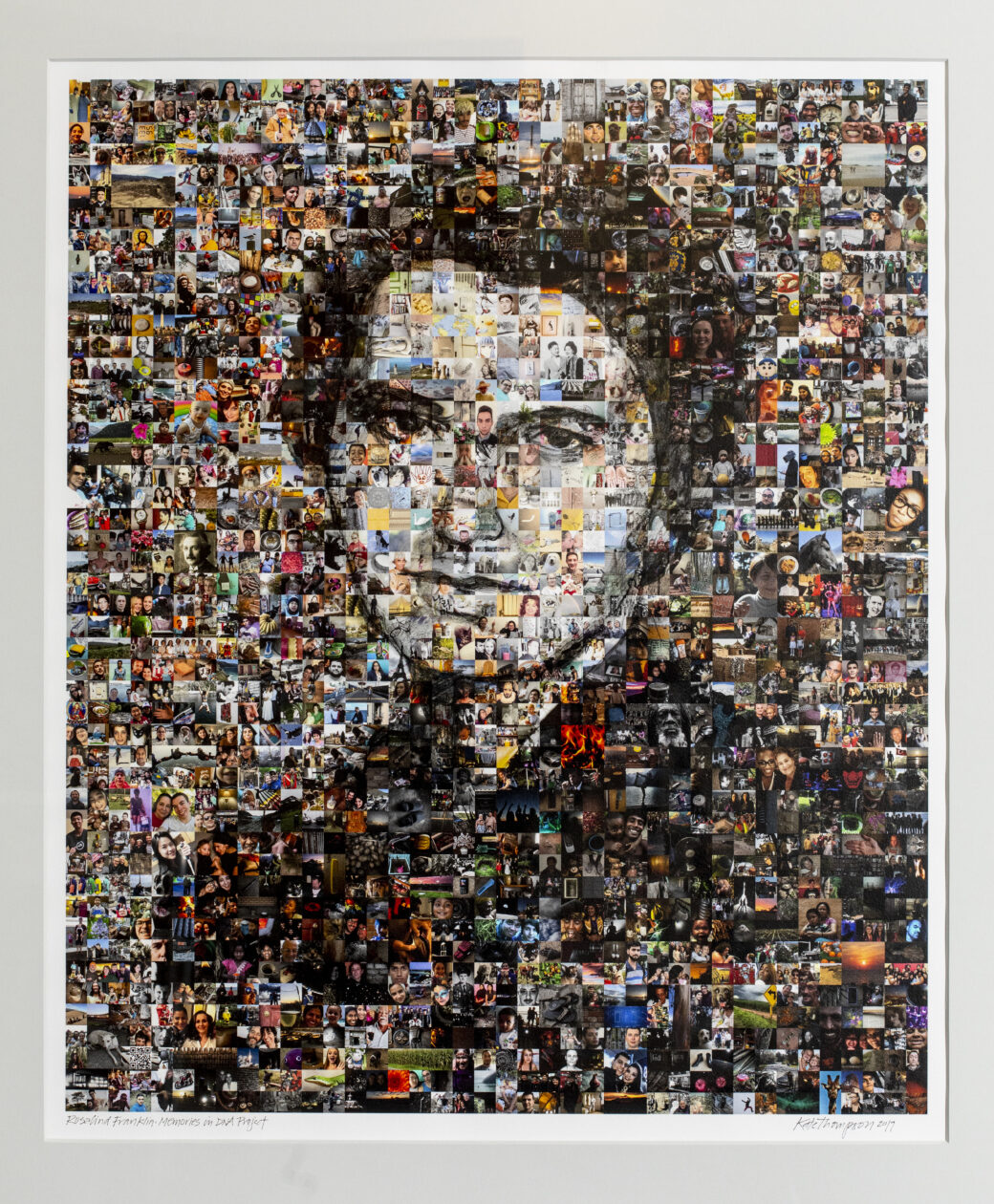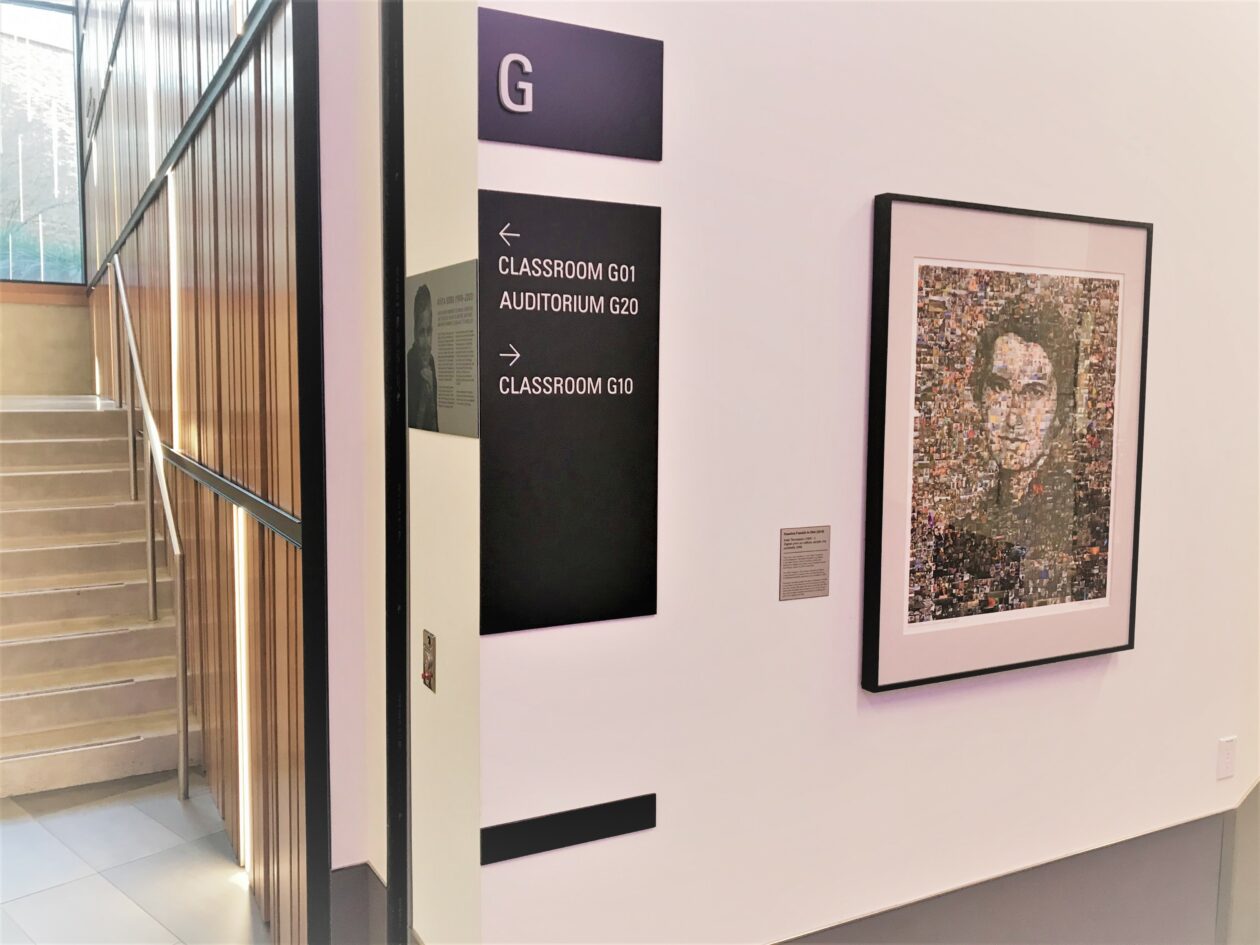
Art imitates life, but few works of art reflect their subject as thoroughly as the portrait of DNA pioneer Rosalind Franklin that’s now hanging in the University of Washington’s Bill & Melinda Gates Center for Computer Science and Engineering.
On one level, multimedia artist Kate Thompson’s work shows the black-and-white visage of Franklin — the late biochemist whose famous “Photo 51” revealed the double-helix structure of life’s most vital molecule, even though she didn’t get her full share of credit for it.
Look more closely, and you’ll see a mosaic of 2,000 images submitted by the general public as part of UW’s #MemoriesInDNA project.
And if you were to scrape off a few flakes of paint and process them in a DNA lab, you could read out the pixels that make up all of those images and more, translated from the four-letter genetic code of life to the ones and zeroes of digital data.
“This portrait is not only preserving Franklin’s memory, but preserving the data as well, in a form that will be accessible to future generations,” Karin Strauss, co-director of UW’s Molecular Information Systems Laboratory and principal research manager at Microsoft Research, said today in a news release about the art project.
Thompson’s portrait arguably ranks as the most visual and publicly accessible demonstration of mass data storage in DNA, which has been the focus of study at MISL for years.
“We’re making steady progress,” UW computer science professor Luis Ceze, the lab’s other co-director, told GeekWire. “We are well, well past the 1-gigabyte mark. But more importantly, it’s less about the volume of data stored in DNA now, and more about showing that there’s a path to getting there.”
The idea of memorializing Franklin in DNA-laced paint got its start over drinks at a pub not far from UW’s Seattle campus, where Ceze and Thompson talked about how to follow up on the artist’s residency at a different UW lab.
“He told me about DNA storage,” Thompson recalled. “So I started researching it a little bit, and I thought, honestly, yeah, we are about to be buried in our information, and it’s simply unsustainable. Which means we’re going to have to do some heavy curating in the future, or find ever-smaller storage media. I am not a scientist, but I love thinking about how you make that real to other people.”
Having an opportunity to highlight Franklin’s story contributed to what Thompson called a “perfect storm” of science, history and art.
“I get to surface a woman who really needs to be surfaced,” Thompson said. “She just won my heart, simply because everything I read about her described her as a difficult woman who knew exactly what she was doing. I just fell in love with her.”
Thompson worked with Ceze and his MISL colleagues to come up with a fitting (and affordable) way to weave together all the threads of the DNA tribute.
First, researchers gathered together a sampling of the 10,000-plus images that had been submitted over the course of more than a year for #MemoriesInDNA. The digitized images were encoded into the chemical base pairs for a DNA molecule — adenine, cytosine, guanine and thymine — and then synthesized by Twist Bioscience, a California company that partners with UW and Microsoft on DNA data storage experiments.
Droplets from the resulting vial of liquid, holding a mere 1.5 milliliters of solution, were mixed into the black acrylic ink for the portrait and into the clear acrylic coating that would go over the finished painting.
“Because DNA as a storage medium is so dense, we were able to provide Kate with around a trillion copies of each image to mix into the paint,” said Bichlien Nguyen, a senior researcher at Microsoft Research.
- DNA pioneer Rosalind Franklin’s visage reflects her legacy. (Mary Bruno Photo via UW)
- Researchers at the University of Washington’s Molecular Information Systems Lab contributed to the DNA art project. (©Tim Griffith / Image Courtesy of LMN Architects)
- Droplets of DNA solution were drawn from a vial and added to black acrylic ink as well as a clear acrylic coating for the painting. (Mary Bruno Photo)
- Artist Kate Thompson created three copies of the Rosalind Franklin in her Vashon Island studio, using the DNA painting method. (Mary Bruno Photo)
- The painting uses DNA-laced ink as well as more than 2,000 images from MISL’s #MemoriesInDNA project to depict DNA pioneer Rosalind Franklin. (UW Photo / Dennis Wise)
- Individual images can be made out if you stand close enough. (GeekWire Photo / Alan Boyle)
- The artist’s signature is beneath the images in the mosaic. (GeekWire / Alan Boyle)
- Team members for the “Rosalind Franklin in DNA” project include (from left) Luis Ceze, David Ward, Bichlien Nguyen, Kate Thompson and Karin Strauss. Team members not pictured: Xiaomeng Liu, Jeff Nivala. (UW Photo / Dennis Wise)
- “Rosalind Franklin in DNA” is on display on the ground floor of the University of Washington’s Bill & Melinda Gates Center for Computer Science and Engineering, at the foot of the Anita Borg Grand Stairway. (GeekWire Photo / Alan Boyle)
Meanwhile, Thompson selected about 2,000 of the #MemoriesInDNA images to go into the full-color printed mosaic that serves as the black-and-white portrait’s background. Drawing upon her past experience as a website art director, she set up an image filter to choose the pictures best suited for colors and shading in different parts of the painting.
Thompson also ensured that the artwork represented a wide selection of people and places. “There were a couple of people who submitted like a hundred of their wedding photos,” she joked. “I would get rid of all but the most important one.”
The whole process took about eight months from conception to completion. Along the way, MISL’s researchers conducted tests to check that the DNA deposited using Thompson’s method could be decoded to produce the original image files.
Both Ceze and Thompson emphasized that the DNA doesn’t reflect the genetic makeup of any organism. Instead, the chemical coding is repurposed to serve solely as a storage medium. One droplet of solution could theoretically store 10,000 gigabytes of data, ranging from historical texts to music videos. And once the DNA is dried out, as it is in the painting, the coding should remain intact for millennia.
DNA data coding hasn’t yet hit its prime, but it’s only a matter of time. Last month, the Intelligence Advanced Research Projects Agency announced that UW and Microsoft would participate in a $25 million DNA data storage development project, and MISL’s researchers are already looking beyond mere data storage. They’re thinking about ways to use DNA in data processing — for example, to search through image databases like the one that was created by #MemoriesInDNA.
In the meantime, the 30-by-40-inch portrait hanging at the Gates Center — and two other copies that Thompson created — will continue to preserve Rosalind Franklin’s legacy, and the visual legacy of those who contributed to #MemoriesInDNA.
“Having a long-term storage medium is super-important. One adjunct to that, that always just makes me smile, is this idea that we’re storing it in a code that any other carbon-based life form could fairly easily decipher,” Thompson said.
“I wish I had a time machine to see what people do with it,” Ceze said.
“Rosalind Franklin in DNA” is on exhibit on the ground floor of the Bill & Melinda Gates Center for Computer Science and Engineering on the UW main campus, at the base of the Anita Borg Grand Stairway. MISL is also exploring the potential to exhibit the artwork at other locations to reach a wider audience.












